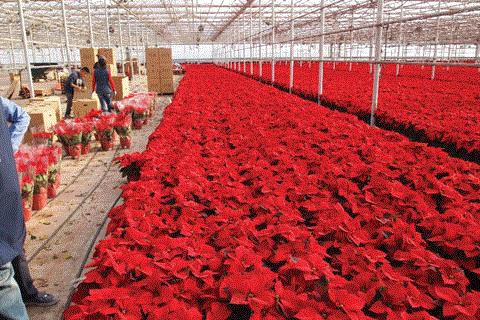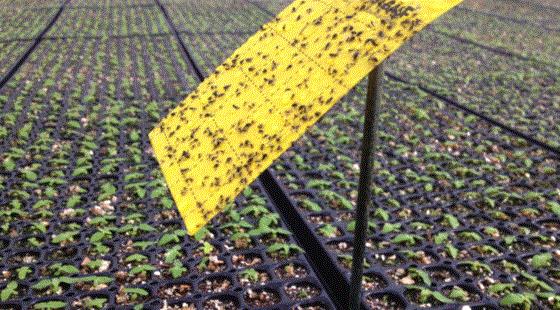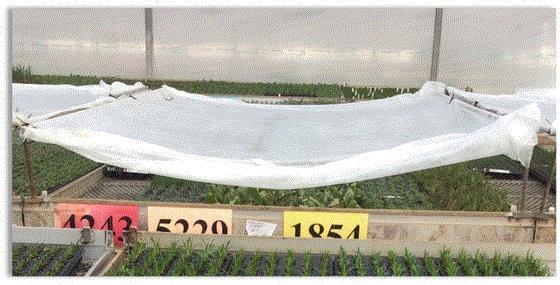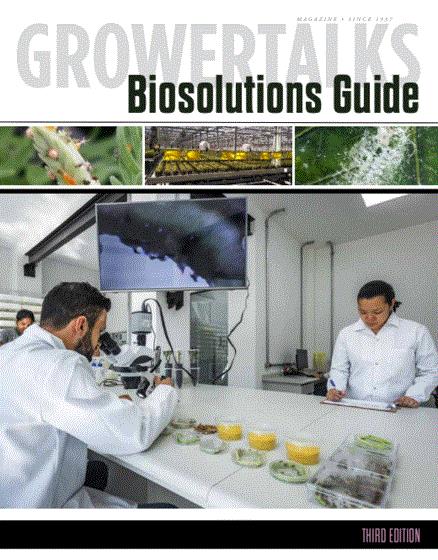Poinsettia Video: Finishing Strong & Successful Shipping
In Episode #35 of our comprehensive poinsettia production series featuring presenters James Doukas, Jason Twaddell and Gary Vollmer from Ball Seed and Selecta One, the experts helped you put finishing touches on your poinsettia crop and send it out the door looking great and ready to hold up at retail until the point of sale.

Feeding to the end, keeping disease in check, and storing and shipping cool are your goals at this final stage. Your poinsettia season is just about over, and the IMPROVING SHELF LIFE video takes you to the finish line.
Here is what our experts cover in this short video:
-
Root protection
-
End-of-the-line cool down
-
Controlling humidity
-
Watch bracts for botrytis
-
Calcium chloride sprays
-
Late paclo drench
-
Feeding to the bitter end
-
Store and ship cool for best results
Nick’s Tip of the Week: Hide & Seek with Bugs
Each week, I’ll work with my buddy Nick Flax, a technical services expert at Ball, to share a concern that’s come up during one of his numerous calls with growers across North America. This week, he has some tips to share with you and your team to help prepare for top-notch pest scouting in 2026.
PROBLEM: A key to revamping your IPM efforts heading into next season is good scouting. I often talk with growers who, despite their best efforts, have a hard time detecting pests early enough to deploy effective preventative controls. Most often, they’ve found themselves overrun by thrips and aphids seemingly overnight and had no idea their populations were building up in the greenhouse.

NICK’S TIP: When we dig a little deeper into their scouting practices, some critical gaps are often identified. This week, I’ll cover best practices on pest monitoring and some less-common places where all of you (and your entire production team) should look for pests when scouting.
Using Sticky Card Traps
One of the most common tools we use to monitor for the presence of pests in the greenhouse is sticky traps. While use of these little 3x5 yellow (or blue) cards may seem like a no-brainer to most, I’m always surprised how many growers I work with don’t use them.
If you don’t currently use sticky cards to help monitor for pests, pick up a few packs ASAP and remember the following when you place them out in the greenhouse:
-
Place one to two cards for every 500 to 1,000 sq. ft. of growing area. More can be used per unit area, but oftentimes more cards do not provide much additional actionable info.
-
When placing sticky cards, ensure that they are at an appropriate height within the crop. Attach cards to a small stake that can be pushed into the growing media and lower the card to just above the crop canopy. If crawling pests like mites are a major concern, putting the trap in contact with the top edge of the container is recommended.
-
Weekly “bug counts” and card swap-outs are strongly suggested, as it can be difficult to determine when pests were detected if cards are left out for longer periods. Fresh sticky traps also make it easier to assess if control measures deployed after a count were effective.
-
Set IPM thresholds based on what is found on your sticky traps and make management decisions based on your findings. For example, if five thrips are found on your card in one week, deploy your first-line control measure. The following week, if 10 thrips are found on the fresh sticky card, it may be time to deploy stronger knockdown controls.
Other Places to Look
While the best place to monitor for pests is within your crops on the bench, this is not the only place you should check regularly. Several other locations that should face regular scrutiny and get a sticky card of their own include:
Hanging basket crops: Most of the time, hanging baskets are significantly out of your line of sight. This makes it very easy for pest outbreaks to occur if they go unchecked. The rule of thumb of one or two cards per 500–1,000 sq. ft. doesn’t really work in this case, so be sure to space sticky cards out in at least two or three spots along a given line of baskets. Placing a trap on the end of a line of baskets near air intakes can also help detect pests that recently entered through vents.
Greenhouse openings: Anywhere that opens to the outside is a potential entry point for flying pests. Doorways that connect directly to the greenhouse, air inlets, breezeways and louvres should each get a sticky card and be checked regularly.
Under benches: If your greenhouse floor is dirt, gravel or another permeable surface, you can be sure that pests are lying in wait down below. Some pests will lay eggs or pupate in soil below your benches, so monitoring pest movement underneath you crops can be a critical indicator of when you need to ramp up IPM measures. Incorporate under-bench bug counts into your weekly process and don’t let this practice fall by the wayside!
Drains and cisterns: In some cases, pests will hunker down in your drains and runoff collection areas between crop cycles or to escape pesticide applications. If your drainage system connects vie open channels between production areas, place a sticky trap at junctions and check them weekly during your normal count.

Breaking the Green Bridge: A Philosophy of Clean Growing
I often include videos, podcasts and documents about the importance of “breaking the green bridge” between seasons—meaning making sure your greenhouses are thoroughly cleaned and disinfested to reduce the risk of overwintering pests and diseases. We have tons of resources to help you and your team build strong sanitation protocols. HERE’S A LINK TO THE ARCHIVE of resources (in the first news item.)

Breaking the bridge means removing all plant material, pots, debris, plastic tarps and any alternative plant hosts from the facility, followed by a deep cleaning and sanitizing of all surfaces—floors, walls, benches and more. Once cleaned, greenhouses should remain plant-free for at least three weeks to ensure potential pathogens and pests are eliminated.
Back in 2023, after seeing some of the resources shared by the Tech On Demand team, Shannon Carmody, Director of Plant Pathology at Ball, offered a thoughtful perspective on the topic and I shared it in a newsletter. As greenhouses are at least partially emptied and cleaned heading into spring 2026, I want to include her comments again because they’re 100% worth offering to your team as a gentle reminder about the importance of sanitation.
Shannon suggests viewing the “start clean, stay clean” mantra as both a technical and philosophical framework. The start clean part depends on beginning with quality inputs and a disinfected growing space. The stay clean component relies on consistent follow-through—sanitation, fungicide and pesticide use, scouting and, of course, discipline.
According to Shannon, the 80/20 rule applies here: 80% of disease problems can be resolved by focusing on a few essential practices—breaking the green bridge and starting with clean material. Without these, even the most diligent daily efforts in scouting or spraying are far less effective.
Breaking the bridge takes time, coordination and discipline. In Washington’s Skagit Valley, for example, beet seed growers remove and store plants through winter to prevent disease carryover—a tradition dating to the 1930s. Similarly, California’s Central Valley enforces a one-month “lettuce-free” period.
The takeaway? True cleanliness requires planning, teamwork and unwavering discipline—because staying clean only works if you start that way.

Powdery Mildew on Succulents: Common BUT Manageable
Succulents are produced throughout the year in many greenhouses and are still trending, creating plenty of demand when customers visit garden centers in spring. Unfortunately, they aren’t immune to disease, and one of the most common is powdery mildew (PM). When growers contact the Tech On Demand team about leaf spotting on succulents, it’s always one of the first issues suspected. Below is a photo from someone who observed brown spots on crassula foliage. In this case, the grower had already started applying some copper-based products based on past experience with similar issues.

After taking a look at the photo (on the right) and talking with the grower, here’s the quick diagnosis and suggested approach to mitigate the issue:
This certainly looks like powdery mildew. PM is generally very host-specific, so seeing it on only this one group makes a lot of sense. Affected leaves won’t recover, but as observed, new growth will cover up the damage if the pressure is kept down.
Try to dehumidify as much as possible during the day and in the late afternoon (without making the heating bill skyrocket) and crank the HAF fans to increase air flow in houses where this is especially problematic.
Regarding fungicide, copper-based products (like what has already been applied) can offer limited control for PM. A suggestion is to rotate in a potassium bicarbonate product for preventative control and when disease pressure is low. Good coverage is critical, as they only work where the active ingredient is actually sitting on the foliage. Use a good spreader-sticker (label permitting) for these surface-protectant type fungicides on succulents, as the thick, waxy cuticle often causes the fungicide solution to bead up on the leaf surface, leaving unprotected “shot-holes” between where the droplets dry. If pressure starts to get bad, rotate in a Group 11 fungicide that is labeled for use on succulents.
I also found an awesome resource from our friends at e-GRO who published a helpful “alert” a couple years ago that will assist you in addressing the issue of POWDERY MILDEW ON SUCCULENTS.

Succulent Propagation BMPs
Let me follow up on the last item with some detailed succulent propagation tips from the Tech On Demand team. Because these crops are most often native to hot, arid regions, the environmental conditions in your greenhouse need to be much dryer than with other ornamentals. Many growers find that misting isn’t necessary and can even be problematic, leading to disease.

Substrate: A wide variety of potting substrates are suitable. Many commercial propagators in North America use a 70% peat/30% perlite blend. This blend lends itself to suitable aeration and drainage proper when irrigation practices are used. Upon sticking, the soil should just be damp—about a level 3 on the 1 to 5 scale—and never saturated.
Sticking: Many succulent URCs are just fleshy leaves and they may not need to be inserted into the soil for rooting. However, the crop time is lengthy, and the plants are generally uneven when propagated from leaves instead of stems. Recognizable stems should be inserted into a dibbled hole, and ensure good stem-to-soil contact is made.
Misting & Moisture: Succulents need low to moderate moisture during propagation. Wet foliage should be avoided as much as reasonably possible. URCs and plants should go into the night with dry foliage to reduce disease incidence, which can permanently scar leaves. Misting is generally not recommended at night, and most succulents are successfully propagated without mist.
Many growers find that wetting the soil (level 3) during sticking and then tenting the crop with Reemay (or similar) is beneficial, while others choose not to tent. This will depend upon your environment.
Light: A light shadecloth (or Reemay) can be beneficial during the first few days of propagation in southern climates if you’re starting plants in summer with high temperatures and high light. Propagation in late fall or spring generally warrants full sun.
Feeding: Low fertilization rates (100 to 150 ppm N) are appropriate from a complete fertilizer selected based on your water quality. Substrate electrical conductivity (EC) levels should be kept below 1.2 mS/cm until roots are established.
Feedings approximately every four days except for Sempervivum varieties, which want feed every two or three days. After two weeks, increase the substrate EC to 1.5 mS/cm.
Disease: Keeping foliage dry is the number one key to reducing disease. Fungicide applications targeting Fusarium, Alternaria and Botrytis are suggested during the first week of propagation. Be sure to follow all label instruction and conduct trials.
Here’s a general prop strategy—keeping in mind, of course, that each variety will require a specific protocol and you always need to be aware of nuances. Work with your suppliers and technical experts if you need assistance putting together the best plan:
-
Stick URCs into a rooting substrate with moisture level 3.
-
Do not apply water for the plants for several days.
-
After several days, a light irrigation and feeding (solution EC of 1.2) can be applied.
-
Moderate to high fertilizer concentrations will burn the tissue.
-
A quick rinse of the foliage may be beneficial to remove fertilizer residue.
-
Shading should only be used to reduce temperature stress when temperatures surpass 80F.

Finish Line …
This past summer, GrowerTalks released the 3rd Edition of our annual Biosolutions Guide and the cutting-edge information included certainly reflects how rapidly the biosolutions industry continues to evolve. The use of bio-based products has become an increasingly critical component of integrated pest management programs. Whether you’re working to minimize the environmental impact of traditional pesticides and fungicides, reduce the risk of resistance, keep your team safe or just exploring natural control strategies, the movement toward biosolutions has become one of the most significant developments in our industry. As you prepare for 2026, I encourage you to take a look and keep the guide handy for reference.
At GrowerTalks, Green Profit and Inside Grower, we’ve been watching this trend closely for years. Our editorial teams collaborate with researchers, product developers and growers to share stories, data and insights across print, digital and audio platforms. Hardly a month passes without us publishing something related to biosolutions.
Since the launch of this supplement in 2023, our goal has been simple: to connect growers with bio-IPM tools that help produce stronger, healthier crops. The first edition explored the need for bio-based approaches and why they matter to all growers. The second dove into best practices, from biofungicide research to bacillus-based biopesticides and banker plant systems.

This year, we took another step forward. The 2025 BIOSOLUTIONS GUIDE examined key supply chain topics—like logistics and BCA viability—while also offering strategies for moving toward bio-IPM through gradual, achievable changes in both mindset and material choices. We hope these guides continue to spark new ideas and inspire discussions about the future of bio-IPM.
Two key features in each of these guides are the biofungicide and bioinsecticide efficacy charts! Be sure to keep these valuable resources at hand, as technologies continue to advance and your prevention and control toolbox expands. And we’ll have a new one ready to mail with the magazines next summer.
Until next week …




Please feel free to send your comments, constructive criticism and topic ideas to me at bcalkins@ballhort.com.

Bill Calkins
Editor - Tech On Demand
This email was received by you and 25,492 other fine subscribers!
If you're interested in advertising in Tech On Demand, contact Kim Brown ASAP and she'll hook you up.